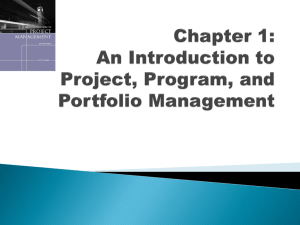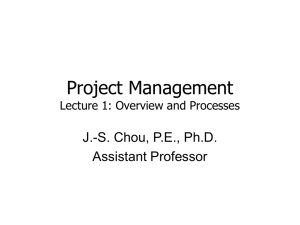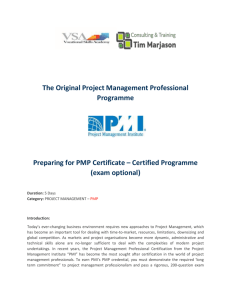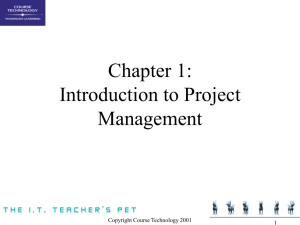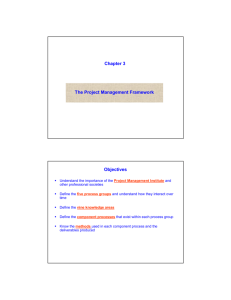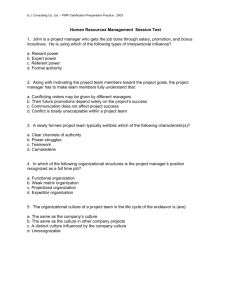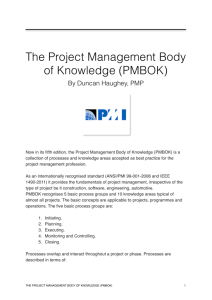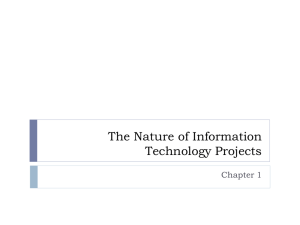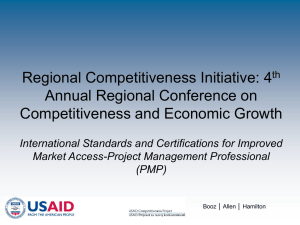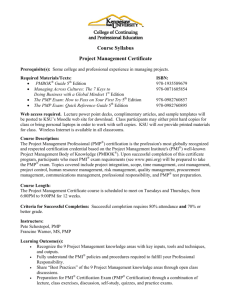Project management - Using the Staff Site
advertisement
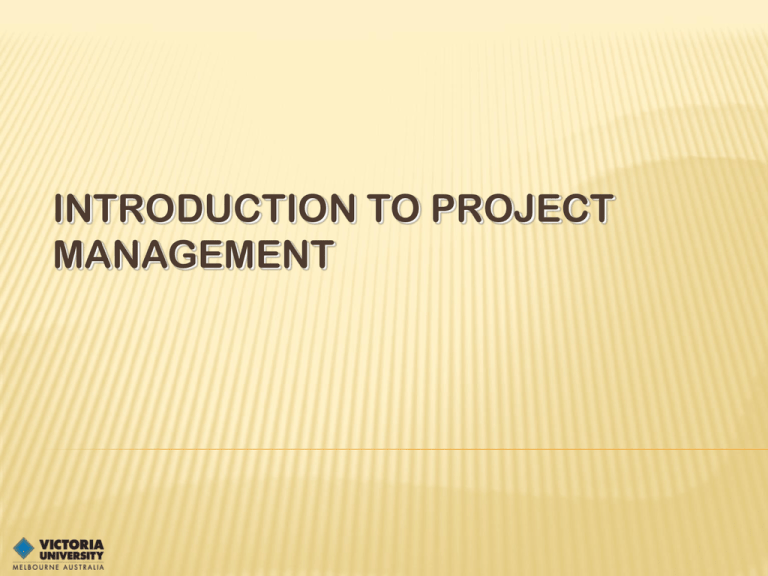
INTRODUCTION TO PROJECT MANAGEMENT LEARNING OBJECTIVES Understand the growing need for better project management, especially for information technology projects Explain what a project is, provide examples of information technology projects, list various attributes of projects, and describe the triple constraint of projects Describe project management and discuss key elements of the project management framework, including project stakeholders, the project management knowledge areas, common tools and techniques, and project success. management profession, including its history, the role of professional organizations like the Project Management Institute (PMI), the importance of certification and ethics, and the advancement of project management software 2 INTRODUCTION (CONTINUED) Many organizations today have a new or renewed interest in project management Computer hardware, software, networks, and the use of interdisciplinary and global work teams have radically changed the work environment The world as a whole spends nearly $10 trillion of its $40.7 trillion gross product on projects of all kinds More than 16 million people regard project management as their profession 3 PROJECT MANAGEMENT STATISTICS Total global spending on technology goods, services, and staff was projected to reach $2.4 trillion in 2008, an 8 percent increase from 2007 In the U.S. the size of the IT workforce topped 4 million workers for the first time in 2008 In 2007 the total compensation for the average senior project manager in U.S. dollars was $104,776 per year in the United States, $111,412 in Australia, and $120,364 in the United Kingdom The number of people earning their Project Management Professional (PMP) certification continues to increase 4 MOTIVATION FOR STUDYING INFORMATION TECHNOLOGY (IT) PROJECT MANAGEMENT IT Projects have a terrible track record, as described in the What Went Wrong? A 1995 Standish Group study (CHAOS) found that only 16.2% of IT projects were successful in meeting scope, time, and cost goals; over 31% of IT projects were canceled before completion A PricewaterhouseCoopers study found that overall, half of all projects fail and only 2.5% of corporations consistently meet their targets for scope, time, and cost goals for all types of project 5 ADVANTAGES OF USING FORMAL PROJECT MANAGEMENT Better control of financial, physical, and human resources Improved customer relations Shorter development times Lower costs Higher quality and increased reliability Higher profit margins Improved productivity Better internal coordination Higher worker morale 6 WHAT IS A PROJECT? A project is “a temporary endeavor undertaken to create a unique product, service, or result” (PMBOK® Guide, Fourth Edition, 2008, p. 5) Operations is work done to sustain the business Projects end when their objectives have been reached or the project has been terminated Projects can be large or small and take a short or long time to complete 7 EXAMPLES OF IT PROJECTS A technician replaces ten laptops for a small department A small software development team adds a new feature to an internal software application for the finance department A college campus upgrades its technology infrastructure to provide wireless Internet access across the whole campus A cross-functional task force in a company decides what Voice-over-Internet-Protocol (VoIP) system to purchase and how it will be implemented 8 PROJECT ATTRIBUTES A project: Has a unique purpose Is temporary Is developed using progressive elaboration Requires resources, often from various areas Should have a primary customer or sponsor The project sponsor usually provides the direction and funding for the project Involves uncertainty 9 PROJECT AND PROGRAM MANAGERS Project managers work with project sponsors, the project team, and other people involved in a project to meet project goals Program: group of related projects managed in a coordinated way to obtain benefits and control not available from managing them individually (PMBOK® Guide, Fourth Edition, 2008, p. 9) Program managers oversee programs; often act as bosses for project managers 10 FIGURE 1-1 THE TRIPLE CONSTRAINT OF PROJECT MANAGEMENT Successful project management means meeting all three goals (scope, time, and cost) – and satisfying the project’s sponsor! 11 WHAT IS PROJECT MANAGEMENT? Project management is “the application of knowledge, skills, tools and techniques to project activities to meet project requirements” (PMBOK® Guide, Fourth Edition, 2008, p. 6) Project managers strive to meet the triple constraint by balancing project scope, time, and cost goals 12 FIGURE 1-2 PROJECT MANAGEMENT FRAMEWORK 13 PROJECT STAKEHOLDERS Stakeholders are the people involved in or affected by project activities Stakeholders include: The project sponsor The project manager The project team Support staff Customers Users Suppliers Opponents to the project 14 PROJECT MANAGEMENT KNOWLEDGE AREAS Knowledge areas describe the key competencies that project managers must develop 4 core knowledge areas lead to specific project objectives (scope, time, cost, and quality) 4 facilitating knowledge areas are the means through which the project objectives are achieved (human resources, communication, risk, and procurement management 1 knowledge area (project integration management) affects and is affected by all of the other knowledge areas All knowledge areas are important! 15 PROJECT MANAGEMENT TOOLS AND TECHNIQUES Project management tools and techniques assist project managers and their teams in various aspects of project management Some specific ones include: Project charter, scope statement, and WBS (scope) Gantt charts, network diagrams, critical path analysis, critical chain scheduling (time) Cost estimates and earned value management (cost) See Table 1-1 for many more 16 SUPER TOOLS “Super tools” are those tools that have high use and high potential for improving project success, such as: Software for task scheduling (such as project management software) Scope statements Requirements analyses Lessons-learned reports Tools already extensively used that have been found to improve project importance include: Progress reports Kick-off meetings Gantt charts Change requests 17 What Went Right? Improved Project Performance The Standish Group’s CHAOS studies show improvements in IT projects in the past decade: The number of successful IT projects has more than doubled, from 16 percent in 1994 to 35 percent in 2006 The number of failed projects decreased from 31 percent in 1994 to 19 percent in 2006 The United States spent more money on IT projects in 2006 than 1994 ($346 billion and $250 billion, respectively), but the amount of money wasted on challenged and failed projects was down to $53 billion in 2006 compared to $140 billion in 1994 18 WHY THE IMPROVEMENTS? "The reasons for the increase in successful projects vary. First, the average cost of a project has been more than cut in half. Better tools have been created to monitor and control progress and better skilled project managers with better management processes are being used. The fact that there are processes is significant in itself.”* *Standish Group, "CHAOS 2001: A Recipe for Success" (2001). 19 PROJECT SUCCESS There are several ways to define project success: The project met scope, time, and cost goals The project satisfied the customer/sponsor The results of the project met its main objective, such as making or saving a certain amount of money, providing a good return on investment, or simply making the sponsors happy 20 TABLE 1-2: WHAT HELPS PROJECTS SUCCEED?* 7. Firm basic requirements 1. Executive support 8. Formal methodology 2. User involvement 9. Reliable estimates 3. Experienced project 10. Other criteria, such as manager small milestones, proper 4. Clear business objectives planning, competent staff, and ownership 5. Minimized scope 6. Standard software *The Standish Group, “Extreme CHAOS,” (2001). infrastructure 21 WHAT THE WINNERS DO… Recent research findings show that companies that excel in project delivery capability: Use an integrated project management toolbox (use standard/advanced PM tools, lots of templates) Grow project leaders, emphasizing business and soft skills Develop a streamlined project delivery process Measure project health using metrics, like customer satisfaction or return on investment 22 PROGRAM AND PROJECT PORTFOLIO MANAGEMENT A program is “a group of related projects managed in a coordinated way to obtain benefits and control not available from managing them individually” (PMBOK® Guide, Fourth Edition, 2008, p. 9) A program manager provides leadership and direction for the project managers heading the projects within the program Examples of common programs in the IT field include infrastructure, applications development, and user support 23 SUGGESTED SKILLS FOR PROJECT MANAGERS Project managers need a wide variety of skills They should: Be comfortable with change Understand the organizations they work in and with Be able to lead teams to accomplish project goals 24 THE ROLE OF THE PROJECT MANAGER Job descriptions vary, but most include responsibilities like planning, scheduling, coordinating, and working with people to achieve project goals Remember that 97% of successful projects were led by experienced project managers, who can often help influence success factors 25 SUGGESTED SKILLS FOR PROJECT MANAGERS The Project Management Body of Knowledge Application area knowledge, standards, and regulations Project environment knowledge General management knowledge and skills Soft skills or human relations skills 26 TEN MOST IMPORTANT SKILLS AND COMPETENCIES FOR PROJECT MANAGERS 1. People skills 2. Leadership 3. Listening 4. Integrity, ethical behavior, consistent 5. Strong at building trust 6. Verbal communication 7. Strong at building teams 8. Conflict resolution, conflict management 9. Critical thinking, problem solving 10. Understands, balances priorities 27 DIFFERENT SKILLS NEEDED IN DIFFERENT SITUATIONS Large projects: leadership, relevant prior experience, planning, people skills, verbal communication, and team-building skills were most important High uncertainty projects: risk management, expectation management, leadership, people skills, and planning skills were most important Very novel projects: leadership, people skills, having vision and goals, self confidence, expectations management, and listening skills were most important 28 IMPORTANCE OF LEADERSHIP SKILLS Effective project managers provide leadership by example A leader focuses on long-term goals and bigpicture objectives while inspiring people to reach those goals A manager deals with the day-to-day details of meeting specific goals Project managers often take on the role of both leader and manager 29 CAREERS FOR IT PROJECT MANAGERS In a 2006 survey by CIO.com, IT executives ranked the skills that would be the most in demand in the next two to five years Project/program management topped the list! 30 TABLE 1-4. TOP IT SKILLS (PARTIAL LIST) SKILL PERCENTAGE OF RESPONDENTS Project/program management Business process management Business analysis Application development Database management Security Enterprise architect Strategist/internal consultant 60% 55% 53% 52% 49% 42% 41% 40% 31 THE PROJECT MANAGEMENT PROFESSION The profession of project management is growing at a very rapid pace It is helpful to understand the history of the field, the role of professional societies like the Project Management Institute, and the growth in project management software 32 HISTORY OF PROJECT MANAGEMENT Some people argue that building the Egyptian pyramids was a project, as was building the Great Wall of China Most people consider the Manhattan Project to be the first project to use “modern” project management This three-year, $2 billion (in 1946 dollars) project had a separate project manager and a technical manager 33 FIGURE 1-6. SAMPLE GANTT CHART CREATED WITH PROJECT 2007 34 FIGURE 1-7. SAMPLE NETWORK DIAGRAM IN MICROSOFT PROJECT 35 PROJECT MANAGEMENT CERTIFICATION PMI provides certification as a Project Management Professional (PMP) A PMP has documented sufficient project experience, agreed to follow a code of ethics, and passed the PMP exam The number of people earning PMP certification is increasing quickly PMI and other organizations offer additional certification programs (see Appendix B) 36 FIGURE 1-8. GROWTH IN PMP CERTIFICATION, 1993-2008 350,000 318,289 300,000 267,367 250,000 # PMPs 221,144 200,000 175,194 150,000 100,000 102,047 76,550 52,443 50,000 40,343 1,000 - 1,900 2,800 4,400 6,415 10,086 18,184 27,052 1993 1994 1995 1996 1997 1998 1999 2000 2001 2002 2003 2004 2005 2006 2007 2008 Year 37 ETHICS IN PROJECT MANAGEMENT Ethics, loosely defined, is a set of principles that guide our decision making based on personal values of what is “right” and “wrong” Project managers often face ethical dilemmas In order to earn PMP certification, applicants must agree to PMI’s Code of Ethics and Professional Conduct Several questions on the PMP exam are related to professional responsibility, including ethics 38 PROJECT MANAGEMENT SOFTWARE There are hundreds of different products to assist in performing project management Three main categories of tools: Low-end tools: handle single or smaller projects well, cost under $200 per user Midrange tools: handle multiple projects and users, cost $200-600 per user, Project 2007 most popular High-end tools: also called enterprise project management software, often licensed on a per-user basis, like VPMi Enterprise Online (www.vcsonline.com) – see front cover for trial version information See the Project Management Center Web site or Top Ten Reviews for links to many companies that provide project management software 39 CHAPTER SUMMARY A project is a temporary endeavor undertaken to create a unique product, service, or result Project management is the application of knowledge, skills, tools, and techniques to project activities to meet project requirements A program is a group of related projects managed in a coordinated way Project portfolio management involves organizing and managing projects and programs as a portfolio of investments Project managers play a key role in helping projects and organizations succeed The project management profession continues to grow and mature 40
